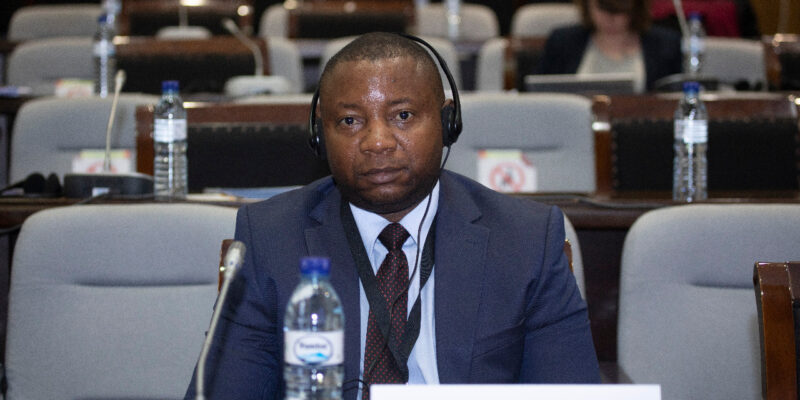The Government, through the Ministry of Mines and Minerals Development, launched the 2022 National Mineral Resource Development Policy (MRDP) on 11th November 2022 and its implementation plan for the period 2022-2027.
The policy sets out the Government’s vision and mission to accelerate and maximise the benefits from the exploration of the known and potential mineral resources available in Zambia.
Thus, re-asserts the central and pivotal role of the mining sector in galvanizing socio-economic development. Critical to the realization of the policy include responding to the inadequacies not addressed in the mining sector during the implementation of the Mineral Resources Development Policy of 2013 while taking into account the new opportunities and emerging issues in the mining value chain.
The Mineral Resources Development Policy of 2013 envisioned a vibrant, well-organized private and private-public partnership-led mining sector. To actualize this, the policy was premised on well-established objectives, which among others, included enhancing exploitation and commercial exploration of mineral resources by local and foreign entities, encouraging local ownership of mineral rights, organising small-scale mining and efficient and transparent management of mineral resources.
During its implementation period, the policy scored some progress towards its core realization, as evidenced by the increased inflow of Foreign Direct Investment in the mining sector and a corresponding increase in copper production, as well as the production of other mineral commodities such as emeralds and manganese in the country.
However, progress has remained relatively low. For instance, the country’s geological mapping and mineral resource exploration is still standing at over 55% of the total surface area, most of which was done before 1998.
In addition, the management of mining rights has been grappled with inefficiencies and mismanagement, resulting in the Government closing the mining cadastre early this year.
Further, much of the activities in the small-scale mining sub-sector remain informal with enormous environmental challenges, poor occupational health and safety coupled with illegal trading in precious and semi-precious minerals and inadequate value addition to mineral products.
On the other hand, inclusivity in the mining sector continues to lag in mainstreaming women, the differently abled and other vulnerable groups in Zambia.
According to the labour force survey (2020), the mining sector employed about 59,371 people, of which 92.2% were male while only 7.8% were female.
Arising from this is the need to develop a comprehensive and responsive National Mineral Resources Development Policy that addresses the aforementioned issues and reconfigures the growth prospects of the mining sector and the country at large.
New and Emerging Issues in the 2022 Policy
The MRDP of 2022 has incorporated new and developing issues taking place in Zambia and, at the international level, which have effects on mineral resource development in the country. This is particularly significant as the mining sector continues to evolve.
Among other opportunities incorporated include the declaration of gold and other minerals as strategic minerals, the electric car value chain advanced by the green revolution, the blossoming of artisanal mining and technological advancements.
Further, the policy has reaffirmed the country’s commitment to scale up copper production by up to 3 million metric tons per annum by 2031 (a projection uncommon with previous policies).
On equity and equality, the policy has advanced quests towards the Agenda 2030 and Sustainable Development Goals (SDGs) through the explicit commitment to not just mainstream gender but also disability and other vulnerable groups in the mining value chain.
However, there is a need to guarantee the participation of women and persons with disabilities to own mining rights by allocating specific targets towards these goals.
Objectives of the Policy
1. Enhance geological mapping and mineral resource exploration to increase commercial exploitation of mineral resources in Zambia: This has been necessitated by the fact that despite a conceited realization of exploration as being the precursor of mining activities, just about 55% of the country has been mapped.
2. Enhance efficiency, effectiveness and transparency in the management and issuance of licenses. Mining rights have for a long time remained a critical issue which has been surrounded by deep-rooted mismanagement. This, among other reasons, buoyed the Government to close the mining cadastre.
3. Facilitate development and growth of the Artisanal and Small-scale Mining (ASM) sub-sector to enhance its contribution to economic development and wealth creation; The ASM is primarily driven by poverty and supports a significant number of the rural population aside from agriculture. Despite a multifaceted realization that the subsector has the potential to improve the country’s resource basket significantly, it has received little attention, as evident from the informalities that continue to plague its growth.
4. Enhance the monitoring of operations and compliance in mining and non-mining rights areas; over the last decade, the country has witnessed an increase in illegal mining operations in protected areas which have seriously threatened their biodiversity.
5. Facilitate the attainment of socially responsible and environmentally sound mining for health, safety and environmental protection; Mining is a very lucrative business. Due to unprecedented youth unemployment and acute droughts, which have affected crop productivity, mining has substituted agriculture in some communities in Zambia. With an exacerbated number of players, there exist instances of unconventional mining practices and a lack of adherence to health and environmental standards.
6. Facilitate ownership and participation of Zambians in the mineral value chain; Large commercial entities of foreign origin dominate the mining industry. Local participation in the value chain is barely seen.
7. Promote value addition in the mineral resource value chain; Value addition is a critical component if the country is to realize the true value of its resource cooperativeness.
8. Facilitate the formulation of a consultative, competitive and sustainable mining tax regime; For a long time, one of the major hindrances to the growth of the mining value chain has been unstable tax regimes.
9. Promote collaboration in Corporate Social Responsibility in the mining sector; mining firms must reserve part of their proceeds of investments to the local community they operate in.
10. Strengthen collaborative Research and Development in the mining sector; research and development are critical for a sustainable mining sector as the sector revolves.
11. Promote skills development among local people to meet the human resource needs of the mining industry; One of the critical aspects of vibrant mining is a skilled workforce, but it has remained elusive, particularly in artisanal and small-scale mining.
12. Mainstream gender, HIV/AIDS, disability and other vulnerable groups in the mining sector. In the quest for the aspiration of a vibrant mining sector, it will be critical that no one is left behind in the value chain. This is also cardinal in realising the country’s commitments to international protocols.
Success Factors of the 2022 National Mineral Resources Development Policy
• The Policy Monitoring and Research Centre (PMRC) urge the Government to establish a national strategic plan for the exploitation and exploration of mineral resources. The plan should incorporate the percentage needed to be mapped, project costs and stipulate incentives for local and foreign investors.
• Aside from employing the Public Private Partnerships (PPEs) model in exploration activities, the Government is urged to utilize other funding avenues from developmental partners such as the European Union (EU).
• PMRC understands that majority of the artisanal miners are poor and undertake mining activities in their remotely located communities. Thus, urging the Government to decentralize the issuance of mineral rights to encourage formalization.
• The 2023 National Budget allocated K50 million towards the artisanal and small-scale mining subsector. PMRC commends the Government for expressing its desire to improve the sector’s informalities and other related inadequacies. However, the country has approximately 500,000 people engaged directly or indirectly in ASM. With the many challenges that impede the subsector growth (lack of equipment, inadequate finances, lack of technical skills), the allocation is seemingly low to advance its quest. Therefore, the Government is urged to increase funding to slightly above K200 million to realize not just Mineral Resource Development Policy (MRDP 2022) tenets but also the subsector potential.
• Regarding the administration of mineral rights, PMRC urges the Government to ensure strict and heavy punishment in accordance with the law is enforced on officers involved in corruption or conflict with the law relating to mining rights.
• Commercial Mining companies remain committed to research and development on process cost reduction and customer satisfaction, which serves their interests and is funded by themselves. Therefore, the Government is urged to channel research and development efforts more to Artisanal and Small-scale Mining, which account for a significant number of Zambians, so as to develop solutions in exploration, mining, processing and conservation and rehabilitation of the environment as well as methods to exploit the value-adding potential of the country’s minerals.












Comments